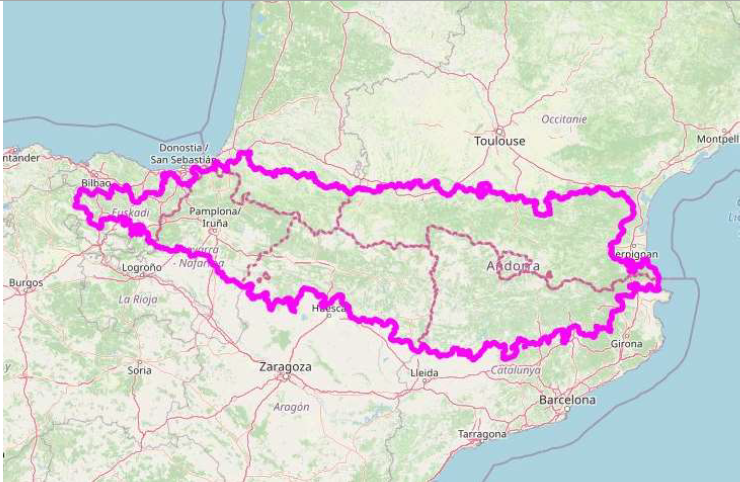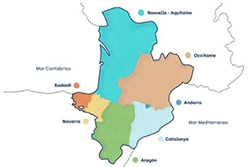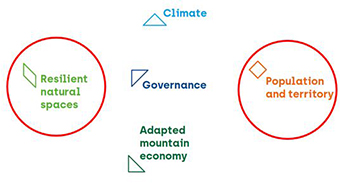
The project aims to implement the Pyrenean Climate Change Strategy (EPiCC), the first European climate change strategy specifically designed for a mountain and cross-border bio-region. The seven EPiCC member territories: New Aquitaine, Occitania, Euskadi, Navarre, Aragon, Catalonia and Andorra actively participated in the development of this strategy.


The PYRENEES4CLIMA project will activate a dynamic for the implementation of the EPiCC. This project will provide the medium-term vision needed to meet the challenges of climate change and will become a real catalyst for climate action policies in the Pyrenees.
The project is organised into 10 working groups (5 of which are the main ones, see illustration below), led by project partners who form north-south tandems, such as the Meteorological Service of Catalonia and Météo France, the Institut Pyrénéen d'Écologie and the Conservatoire Botanique des Pyrénées, the Réseau Pyrénées Vivantes and the Autonomous University of Barcelona, the Occitanie region and the OPCC - CTP...
 Sud-Ouest is contributing to 2 working groups:
Sud-Ouest is contributing to 2 working groups:
- One on resilient natural areas, innovation in observation networks to reduce vulnerability (WP 3)[1] ;
- The other on populations and territories (WP5).
STUDY OF ECOLOGICAL CONTINUITY

As part of WP3, Cerema will be working on identifying ecological continuities at the scale of the Pyrenean massif.
Mountain species are highly sensitive to climate change. Some habitats, plants and animals are likely to see their home ranges move further up the mountain or perhaps disappear as a result of global warming. Preserving and restoring high-quality natural habitats, and especially their connections, will enable species to adapt better to the effects of climate change.
Initially, it will be necessary to carry out an analysis of ecological continuity, which will serve as a basis for harmonised and concerted conservation and restoration measures throughout the Pyrenees between Spain and France.
This study will also contribute to the European Union's biodiversity strategy for 2030, one of the objectives of which is to have a coherent and resilient trans-European nature network.
The 7 member regions of the CTP will be responsible for steering, leading and governing the study.
Cerema will be responsible for the production and technical coordination of the task for which it is responsible, with the contribution of the Conservatoire Botanique des Pyrénées et Midi-Pyrénées (CBNPMP) and in partnership with the University of Barcelona, the Institut Cartographique et Géologique de Catalogne (ICGC) and the Franco-Spanish-Andorran grouping FORESPIR.
Cerema's mission will be carried out in co-construction with its partners in several phases:
- Land use mapping;
- Development of an ecological continuity modelling method;
- Identification and mapping of ecological continuity elements (biodiversity reservoirs [2] and ecological corridors [3]);
- Identification of anthropogenic pressures and fragmentation;
- Identification of habitats vulnerable to climate change;
- Proposal of demonstration sites to promote habitat reconnection measures.
ON RISKS AND AVAILABILITY OF WATER RESOURCES

Two contributions from Cerema on WP5 "Population and territory":
- The first concerns the analysis and evaluation of water management in the Pyrenees;
- The second concerns the development of methodologies for natural risk management in the Pyrenean mountains in the face of extreme events.
With regard to the first topic, the aim is to take into account the quantitative challenges of water resources in the context of climate change. The overall objective will be to develop a water management strategy in a context of increasing scarcity of water resources and in relation to the GEMAPI.
Several areas of work will be developed:
With regard to the second topic, the aim is to develop a methodology for building resilience strategies for territories in the face of climate change. The idea is to look at natural risks and how they are changing, and to broaden our vision so that we can work on a multi-sectoral strategy. We also want the development of this strategy to be collaborative and participatory. The aim is to get local players involved in a dynamic, a willingness to act together on their territory.
As part of the Montclima Interreg project, Cerema worked with the municipality of Les Eaux-Bonnes, at both municipal and basin level, to co-construct a resilient development strategy. On the basis of this experience, the work should now be continued and developed in a number of areas:
- Changing scale to find a more operational area of action. This is why it is proposed to work on the scale of a larger cross-border area, such as the EPCIs of the Ossau valley on the French side and the Tena valley on the Spanish side.
- Disseminate the working method on resilience to risks and climate change in Spain. At present, this approach is not very well developed in Spain. The idea is to share our methods and knowledge with our border partners. In this way, a strategy will be developed in a Spanish pilot case. The Pirineos-Pyrenees EGTC [4] would therefore be the preferred partner for this transposition.
- Deepen the action plan resulting from the cross-border resilience strategy to develop the operationality of the territorial approach to risks. In this way, the key elements will be worked on with local stakeholders in practical, viable and sometimes innovative solutions. The pre-established themes are tourism, agro-pastoralism, risk culture and spatial planning solutions. In addition, a partnership with AUDAP [5] will enable the development of a reference framework for the development of mountain communities, taking into account the diversity of risks in the Pyrénées-Atlantiques department.²
______________________________________________________________________
[1] Workpackage
[2] Areas where biodiversity is richest and best represented
[3] Areas where species move between biodiversity reservoirs
[4] The European Grouping for Territorial Cooperation is an instrument for cross-border cooperation between the Autonomous Community of Aragon, the Diputación de Huesca, the Department of Hautes-Pyrénées and the Department of Pyrénées-Atlantiques, created with the aim of stimulating and strengthening cooperation and joint action in these territories.
[5] Atlantic & Pyrenees Town Planning Agency

